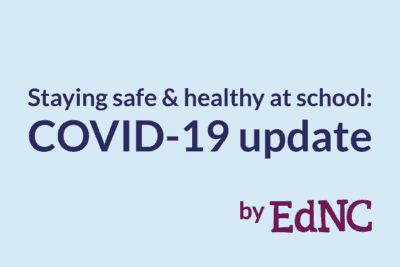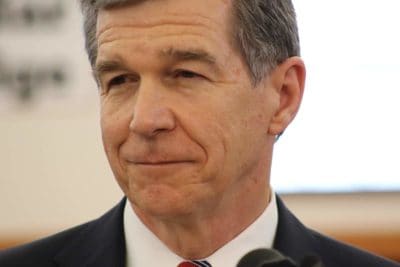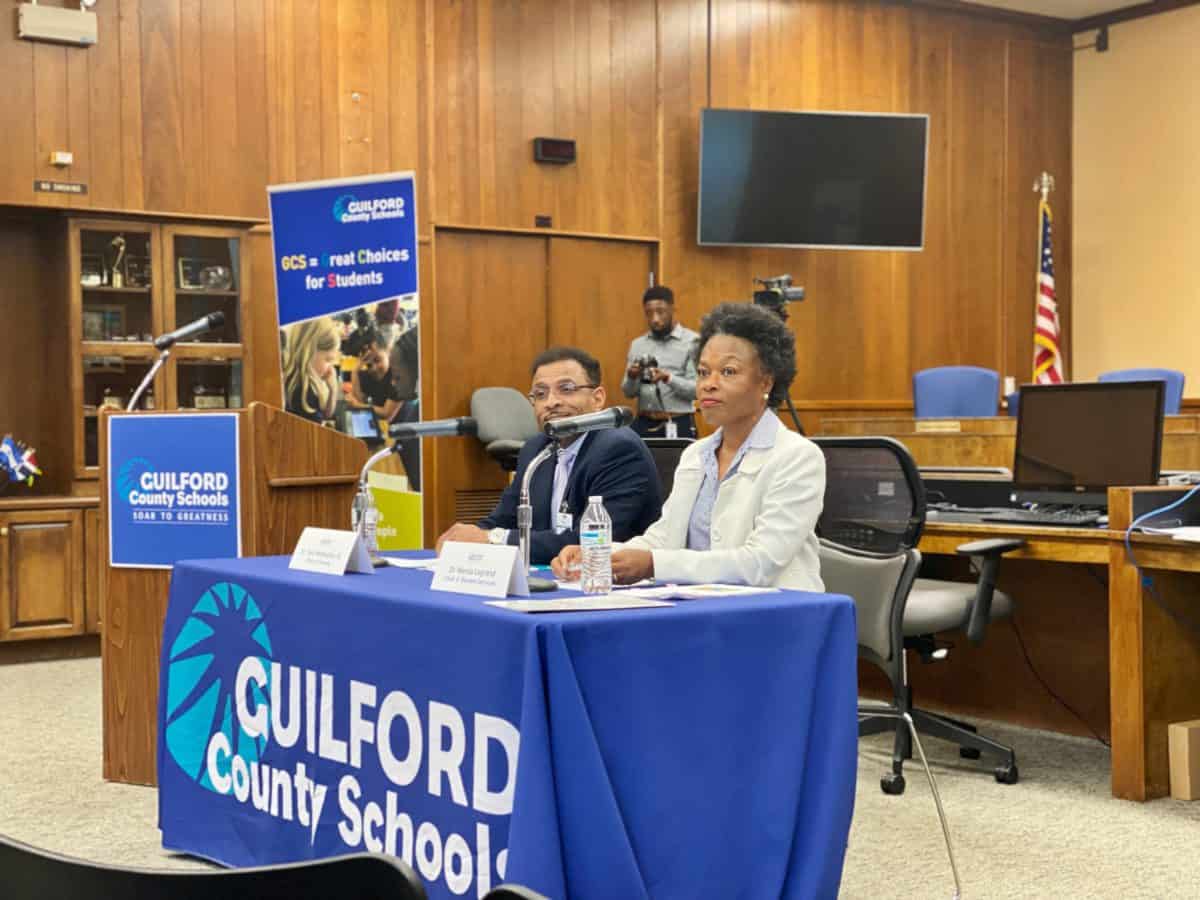
We are focusing our coronavirus coverage on impact to North Carolina schools. Click here for the latest updates from the North Carolina Department of Health and Human Services. Read our summary of the latest preparations happening in North Carolina schools here.
A collaborative process: Districts and departments come together to plan
In late February, when coronavirus cases started growing nationally, Wanda Legrand, chief student services officer at Guilford County Schools, started coordinating “all the departments that could possibly be needed” to create a comprehensive coronavirus preparedness plan, including: chief of schools, chief of staff, maintenance and transportation departments, communications, academic services, and health services.
On March 11, a 21-slide external report was released to the Guilford County Board of Education, media, and the public. The “GCS COVID-19 Plan” includes guiding principles, toolkits, communication plans, and multiple phases ranging from preparedness to what would happen if there were multiple confirmed cases in the district. While the guiding strategy of the plan is to protect Guilford County students and staff, this work is also an example of creating procedures on a district level that are rooted in collaboration.
At the request of district Superintendent Sharon Contreras, Legrand brought together leaders from the 10 largest school districts in North Carolina. A few weeks ago, they convened in Greensboro along with public health officials to go over the most recent Centers for Disease Control and Prevention guidelines and to get an overview of what was happening both nationally and statewide.
“Under Dr. Legrand’s leadership, Guilford County came with a partial plan already in place, so I think the other districts really appreciated that,” said Tony Watlington, chief of schools for the district.
That initial plan came together in a few parts:
- First, representatives from all the departments in the district met in person. They created an initial fact sheet which was publicized by the communications department.
- Then, they organized a larger meeting via conference call with public health officials, including the Guilford County community health and emergency management departments.
- This was followed by a larger in-person meeting where the district said: “forward this invite to others in your department.” That’s when district officials started to look at CDC guidelines for schools and divided them up. “They have home guidelines, travel guidelines, cleaning guidelines. The CDC has everything. Everyone had their piece. And we created strategies and then we put them together,” Legrand said.
- The communications department made sure “their I’s were dotted and T’s were crossed,” and the work was publicized.
Legrand was careful to highlight that the whole process was a team effort. Watlington made sure all the principals had what they needed. Whitney Oakley, chief academic officer, made sure they addressed academics. Angie Henry, chief operations officer, focused on buses, nutrition, maintenance, and custodial business.
“It’s not just me. It’s a team,” Legrand said.
Guilford’s advice for districts creating their own plans
When asked what advice they would give to other districts putting together their own preparedness reports, district officials emphasized the importance of teamwork.
“To bring everyone together and to continue to bring everyone together to have those conversations,” Legrand said, even if that needs to happen virtually. She added that Nora Carr, chief of staff, made sure that all the parts and pieces were aligned.
Other advice included:
- Use the resources from your local experts. Guilford County Schools focused on pulling guidelines from the CDC, the NC Department of Human Services, and the Guilford Department of Health. “CDC has all the guidelines, we’re just publicizing them,” Legrand said.
- Science is key. “We are really encouraging people to go to those most credible resources where the science and research and experts are. I mean certainly, we track news coverage and other info, but in terms of what we rely on for guidance, we are encouraging people to go there,” Carr said.
- Have a strong relationship with your county officials. “We aren’t MDs, we’re not RNs. Our health department has been there for us. We call Friday night with a question, Saturday morning with another question. We ask them to come and they come,” Legrand said. “So they are always there, they are the experts when it comes to health, health services, and disease control and management.”
- Let the experts help. “Our health department has been fantastic, so lean on them. You might be concerned and nervous about answering questions that are outside of your wheelhouse, and you should be. So reach out to those who own that wheelhouse and hopefully they’ll be as responsive as ours has been,” Legrand said.
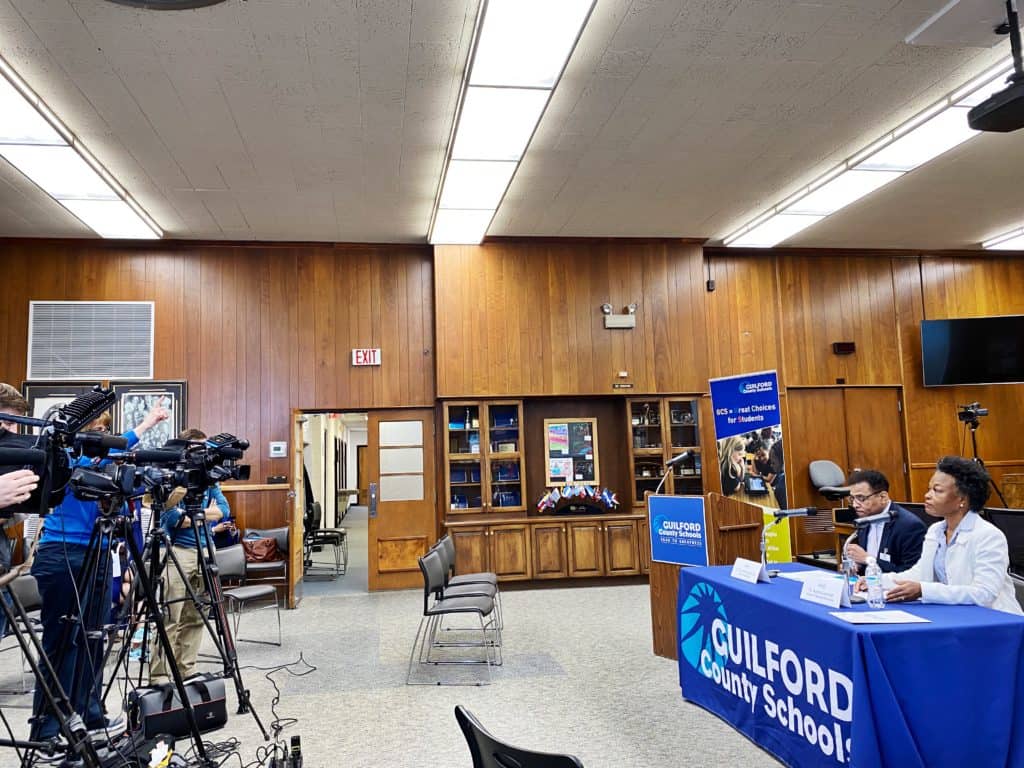
Thinking about the students: ‘A delicate balancing act’
Guilford County Schools is an urban district with a poverty rate close to 70%, according to Carr.
“We have to really be conscious of the impact that closing school and restricting opportunities for students has on their health and well being,” she said. “It is a delicate balancing act and it’s something we have to continually review, and as new info becomes available, we will adjust our plans and our communications accordingly.”
“We also know that … students are relying on us for basic necessities like food and clothing and clean clothing as well as their educational needs. Not having access to that is not going to help their health situation,” Carr added.
During the press conference releasing the plan to the public, district officials said they are working with community partners, nonprofits, and faith-based institutions to create plans for sending food home with students who rely on the district for daily meals in the case that schools close.
“What is that right balancing act in wanting to be proactive, wanting to be well-prepared, to stay up daily with where this is going and what’s happening,” Carr said. “But at the same time not panicking and overreacting and making decisions out of fear, but based on science and research and the best advice we can get from the experts.”
Carr cited The National Association of School Psychologists which has released fact sheets on talking about coronavirus to students.
“It walks them through how to talk to your child about this and helps them understand what is happening without creating fear,” she said. “I’ve relied on their materials for a varied of issues weather its a violence situation or a variety of things and I recommend them to you and others.”
Explore Guilford County Schools’ COVID-19 preparedness report
The report was created by Sharon Contreras, the district’s superintendent, Legrand, and Watlington. The following are excerpts from the report along with information provided by the authors.
Planning process
Here’s a list of the CDC’s resources for educators, including “interim guidance for administrators, childcare programs, schools and school personnel.”
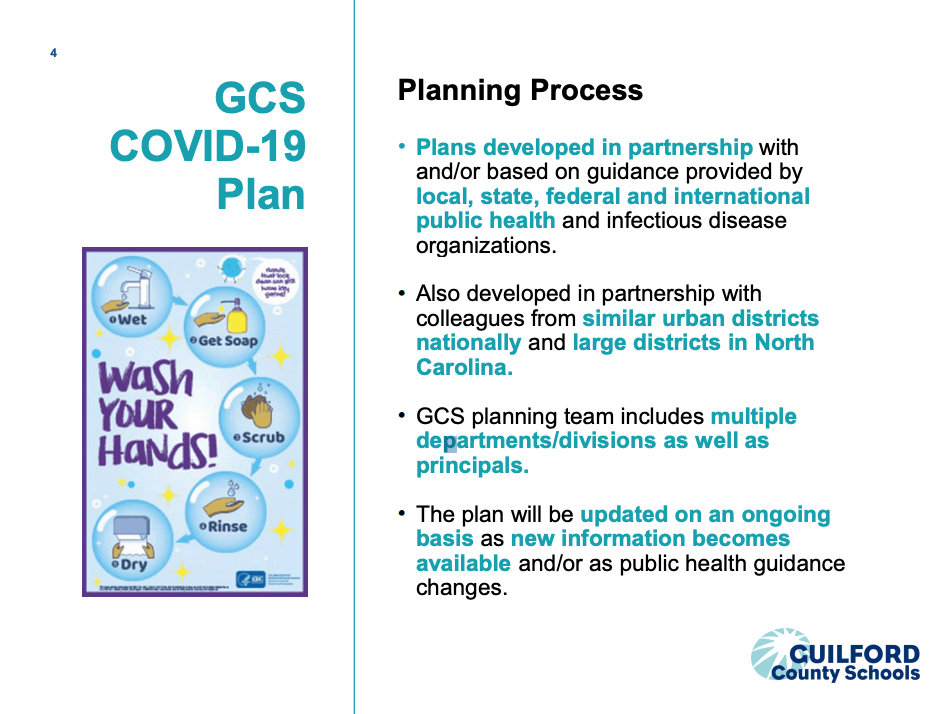
Guiding principles
Simple action-oriented goals to steer decisions for school administrators and teachers. “Review and adjust plans and communication frequently as new information becomes available,” is an important principle as this is an evolving situation.
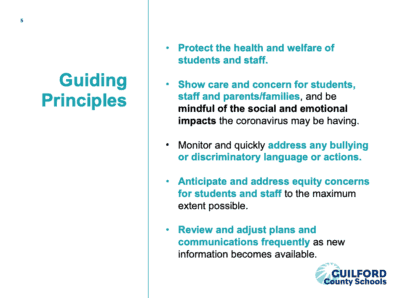
Four phases
- Phases I and II include preparation and public health communication (I) and a “confirmed case in Guilford county” with the goal to “limit community spread to schools without disrupting learning” (II).
- Phase III includes a confirmed case in Guilford County Schools and phase IV is confirmed cases in multiple district schools.
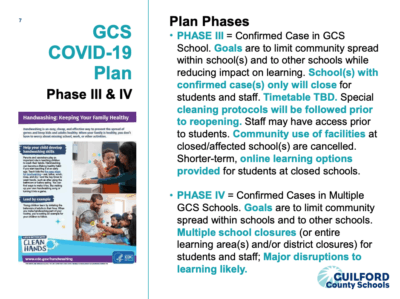
Toolkit
The COVID-19 Toolkit for principals includes:
- GCS fact sheet (also in Spanish, French)
- CDC fact sheet (also in Spanish)
- NC public health fact sheet (also in Spanish)
- Handwashing elementary girl (also in Spanish)
- Handwashing elementary boy (also in Spanish)
- Handwashing middle and high school (also in Spanish)
It also includes a principal checklist, guidelines for field trips, important phone numbers, and links to resources such as CDC COVID-19 information and North Carolina Public Health COVID-19 information.
Communications
With monitor and adjust as needed as the center circle, the communication web includes both internal communications such as employee communications, toolkits for GCS leaders and principals, as well as external communications such as phone, text, emails to parents, social media, website, and TV updates.
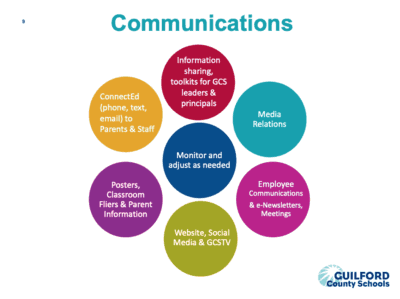
Policy implications
This guides what policy the district will follow. The image below outlines the district’s emergency closing process.
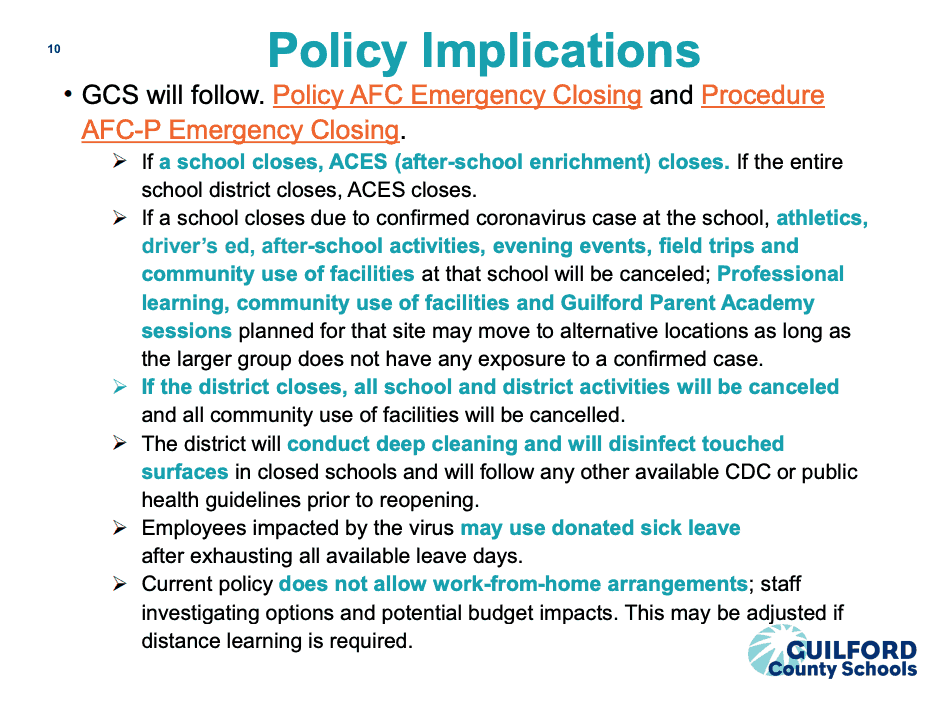
Phase I – Preparation and communication
The following slides show different preparations for Phase I, including:
- Purchases and production of materials. Large quantities of hand soap, paper towels, etc.
- Meetings, including those with staff, emergency management, and health departments.
- Training, including exploring online options.
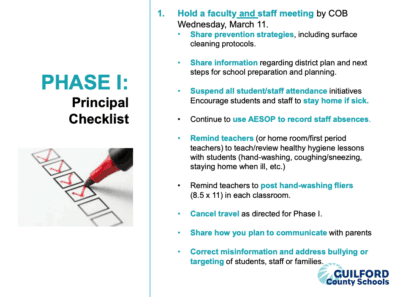
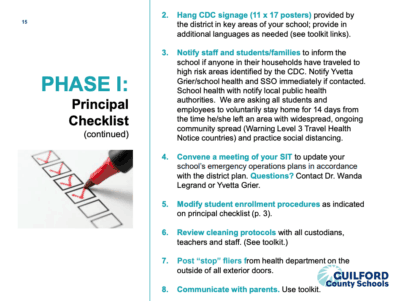
Phase II – Locally confirmed case
The goal of Phase II is to limit community spread to schools without disrupting learning.
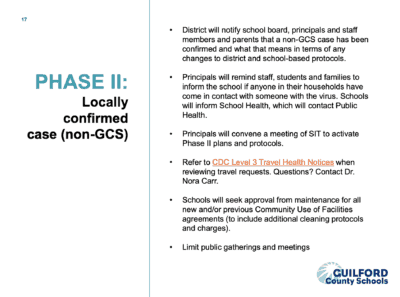
Phase III – Confirmed case in Guilford County Schools
The goal of Phase III is to limit community spread while reducing impacts on student learning.
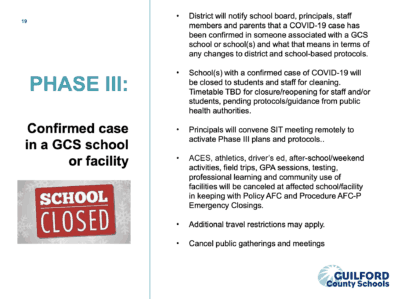
Phase IV – Multiple confirmed cases in Guilford County Schools
The goal of phase IV is to limit community spread within schools and to other schools. During this phase, major disruptions to learning would be possible.
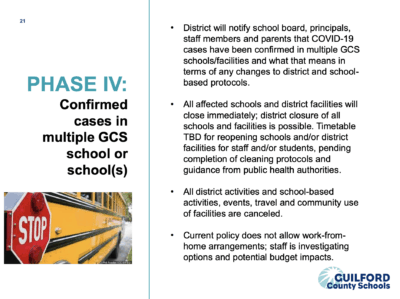
Share your voice with us: Have you started a preparedness plan?
Interested in daily updates on the impacts of coronavirus on North Carolina schools? Sign up for our daily newsletter here.
Sign up for the EdDaily to start each weekday with the top education news.
Recommended reading
